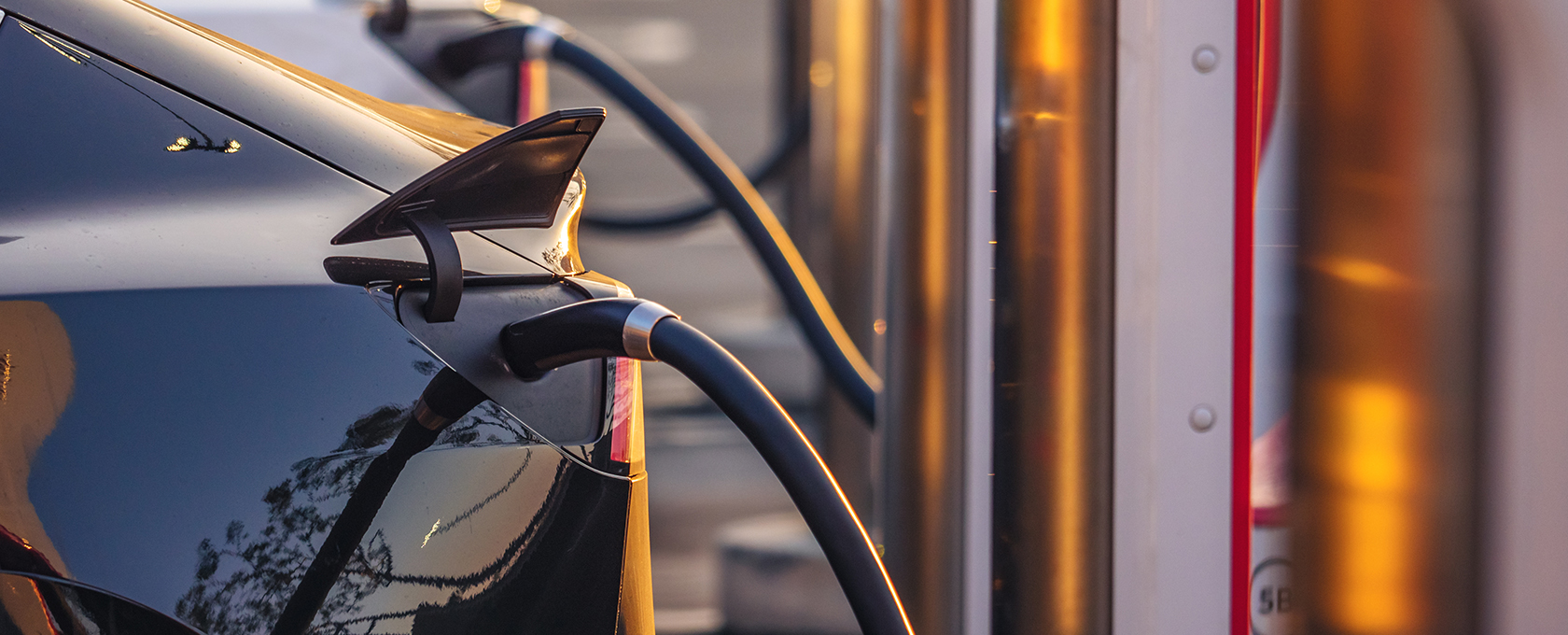EV and EV-Infrastructure Deployment Encounters Regulatory, Political, and Market Challenges in 2024: Hitting Speed Bumps or Shifting into Reverse?

The road to electrified mobility has been a tumultuous one for automakers, battery-electric vehicle (EV) infrastructure developers, and their supporting industries.
Global EV technologies and trends are evolving rapidly, creating market opportunities for companies that can adapt quickly and challenges for those who cannot. On top of swift change, progress in 2024 has coincided with global trade investigations, domestic political developments, and a reassessment of trends in the EV market.
As the outlook for 2025 takes shape and key stakeholders in the EV sector consider investments that will impact the future of electrified mobility, a crucial question arises: are market developments and uncertainties mere speed bumps to EV adoption, or could they signal longer-term, more fundamental realignment of the industry?
Global EV Market Trends – Chinese EV Dominance, Trade Disputes, and the Shifting Landscapes
In 2023 production of EVs exceeded 14 million units, representing 16.5% of the global automobile market. This marks a significant increase from 13% in 2022, and more than a 4-fold increase since 2019.
China
The People’s Republic of China (PRC) presently dominates the global EV market, accounting for 60% of worldwide EV sales. PRC-based manufacturers continue to report robust sales for late-2024. This strong position is bolstered by government sponsored trade-in subsidies and a significant increase in export-volume.To stimulate demand within China’s borders, PRC authorities in July announced an allocation of 300 billion Chinese yuan ($41.5 billion USD) in ultra-long special government bonds to expand existing trade-in and equipment upgrade policies. These support spending-incentive policies aimed at boosting consumption, and half of the allocation will be used to create vehicle trade in programs and similar incentives for consumables.
Exports and production by PRC-based companies have ballooned at staggering levels, and EVs manufactured in the PRC represented over 20% of the EU’s EV sales in 2024. This volume is up from 3% in 2020, according to data from the European Automobile Manufacturers’ Association (ACEA). Cars imported from the PRC represented 7.6% of the European market share in 2023. In the Americas, the PRC-based manufacturing company BYD predicted it will sell 100,000 EVs in Mexico in 2025, up from 50,000 in 2024.
Rising Trade Tensions and International Tariffs
The expansion of activity has not gone unnoticed, however, and on October 29th the European Commission moved ahead with rules to implement tariffs of up to 45% on electric cars made in China. The PRC government indicated it may raise tariffs on certain imported internal combustion engine vehicles in retaliation to the EU’s tariffs.
According to a Wall Street Journal study of Chinese EV company investments, Brazil raised its tariffs on EVs with Chinese components to 18% in July from 10%. The tariff will rise again to 35% in July 2026. Turkey has imposed an additional 40% duty on electric cars from China since July, while in Canada a 100% tariff on Chinese-made EVs took effect October 1st.
U.S. Political Landscape: The Impact of the 2024 Election on EV Policy
Republican Influence on EV Policies
Trends in the U.S. have significant bearing on global markets, and EVs and international trade policy were prominent issues during the nation’s 2024 general election cycle.
Election results, particularly unified Republican control of the Presidency and both Houses of Congress, is expected to have a large impact on policy and regulations relating to EV infrastructure, research, tax credits, and rebates. President-elect Trump and some Congressional Republicans have called for a repeal of the Biden Administration’s Inflation Reduction Act (IRA)’s EV purchase incentives and to “rescind” any unspent funds earmarked in future budgets for climate provisions.
Other Republicans — including House Speaker Mike Johnson (R-LA) — have taken a cautious tone in favor of making more surgical changes to the IRA’s EV incentives, presenting a chance for EV stakeholders to help shape GOP policy. Democrats remain almost uniformly supportive of the IRA, which is expected to further stifle calls to fully repeal all IRA tax credits and jobs-related programs.
Supply-Chain Changes
If the Trump administration successfully repeals EV purchase incentives, EV stakeholders will need to be proactive in addressing policy risks and assessing how the new administration will seek to promote the American economy, workers, and strategic interests. The change of administrations and new policies may impact ongoing domestic battery technology developments and could, at least temporarily, affect the ability of domestic U.S. EV manufacturers to compete on price with internal combustion engine (ICE) and Chinese EV offerings. Nonetheless, manufacturers are adjusting to the realignment of trade dynamics, with Australia emerging as a key alternative supplier and world leader in lithium production and accessible cobalt. As an example of steps being taken to establish western-ally reliant supply chains, General Motors has entered into an agreement with the Australian mining giant Glencore to mine and process cobalt in Western Australia for its Ohio battery plant.
End-of-Term Congressional Session
As Congress returns for its final 2024 “lame-duck” session, it is expected that, for the time being, progress towards rolling out IRA programs will continue. An additional $521 million in Federal grants were announced in late August by the Biden Administration to establish over 9,200 EV charging stations and to build alternative-fueling infrastructure. Since 2021, the number of publicly available EV chargers has doubled nationwide and there are currently over 192,000 publicly available charging ports with approximately 1,000 new public chargers being added each week. It remains to be seen whether this trend will continue or stall with the new administration.
U.S. Tariffs and Domestic Trade Policies
Precisely how the incoming Trump administration chooses to implement tariffs will be another factor for the EV industry to navigate.
However, the push for adoption of tariffs and other import restrictions appears driven by ongoing analysis from various executive departments, rather than being strictly tied to any particular executive administration’s political agenda. For example, on September 23 the U.S. Commerce Department announced a proposed national security and supply chain action which prohibits the sale or import of vehicles and components designed, developed, manufactured, or supplied by entities with a sufficient nexus to the PRC or Russia. While much of the focus of this action is on connectivity technologies, the proposal likely would have a significant impact on battery and other EV component import practices. Prohibitions on software would take effect as of model year 2027. Bans on the import and sales of hardware would begin model year 2030, or as of Jan. 1, 2029, for units without a model year. The Commerce Department has framed the rulemaking as a deterrent to foreign surveillance, sabotage, and undermining U.S. national security, and to date no indications suggest that the change in administrations will affect implementation.
The United States-Mexico-Canada Agreement (USMCA) also is set to automatically sunset in 2035 unless extended through a review process. Inroads by Chinese EV makers such as BYD in Mexico have led to speculation that president-elect Trump will invoke the six-year renegotiation provision to address disputes over vehicle and component rules of origin, and to hinder the PRC’s ability to indirectly access markets through perceived local sourcing loopholes in the USMCA.
EV Market Dynamics and Consumer Trends in the U.S.
Labor Dynamics
The 2023 United Auto Workers (UAW) strike—the first simultaneous strike against Ford Motor Company, General Motors, and Stellantis in the union’s history—left a lasting impression on the global industry by significantly affecting automakers’ net profits in the second half of 2023. In total, the strike has been estimated to have caused an estimated $4.2 billion in losses to the Big 3 and resulted in $488 million in lost wages for workers during the times when production lines were offline. While the U.S. Bureau of Labor statistics estimates that less than 20% of auto works in the United States are members of a labor organization, wage increases including a 60% increase in starting salaries for new certain new production line hires could result in noticeable new costs and labor dynamics for manufacturers. Ford Motor Company, for example, estimated the renegotiated contracts will add an additional $900 per vehicle in future labor costs.
Some analysts suggest that tensions between the union and automakers could turn divisive if cost cuts are required for UAW plants to remain competitive against non-unionized global competitors. The UAW was successful in recently organizing the GM battery plant in Spring Hill, TN.
Interest Rates and Inflation
The role of interest rates is a perennial concern in the capital-intensive EV business, and cost-of-capital considerations remained top-of-mind for many businesses throughout 2024. As the U.S. Federal Reserve begins its first round of rate cuts since the COVID-19 pandemic, starting with its September 50-basis point cut, contractors, developers, and manufacturers experiencing record-high construction costs are hopeful projects can move ahead more smoothly as interest rate pressure falls. Additional cuts of up to another 50 basis points are expected for the balance of 2024, and trends towards lower interest rates in 2025 remain a hot topic of discussion for the Federal Open Market Committee.
Consumer Trends; Costs
Despite a complex regulatory landscape, EVs have become increasingly commonplace in the U.S., and as a result, OEMs and other players in the EV ecosystem have gained valuable insights into factors that could either accelerate or limit their broader-scale adoption. Especially in the U.S., upfront vehicle cost remains a critical consideration for consumers deciding between EVs and ICE vehicles.
Kelley Blue Book estimates the average U.S. transaction price for new vehicles at $47,870 as of September 2024 — over $15,000 higher than the average price a decade ago. For EVs, that figure rises to $56,575. This higher upfront cost for EVs, combined with uncertain resale values given the relative newness and changing landscape of battery technologies, complicates the transition to electrification. While some resale uncertainty is due to rapid advancements in battery technology, this is coupled with a continuing demographic trend of many U.S. EV buyers preferring more expensive, faster depreciating EV options like large SUVs. Although lifetime maintenance, consumables, and overall ownership costs for EVs may be lower than those of ICE counterparts in some segments, initial sticker shock continues to significantly influence consumer decisions.
Despite vocal support for EV adoption and offering incentives that exceed industry averages, traditional vehicle manufacturers still also appear to hold hedged opinions about the pace and scope of their transition to electrification. In 2024, EVs are projected to account for only 1.3 million of the approximately 16 million vehicles sold in the U.S. While 2021 saw enthusiastic calls for 50% EV adoption within the next decade, more recent communications from manufacturers suggest that production targets are expected to increase at a more measured pace towards 30% or 40% by 2030. Market saturation may not exceed that level in the foreseeable future unless consumer preferences change or battery technologies, and hence ranges, substantially improve with coincident lowering of costs.
Capital Expenditure and Infrastructure Challenges; Standardization.
The practical consequence of tempered assessments has been a dialing-back of certain capital investments and transitions to investments in hybrid and hydrogen drivetrains. Many OEMs are looking at hybridization as a bridge to an all-electric future. Suppliers’ have been tasked with adjusting their volume projections, operations, and staffing needs accordingly.
From an infrastructure perspective, the costs and bottlenecks associated with installing new EV charging stations also continue to present significant challenges. Utility delays can extend the timeline for charging installations from months to years, and managing interconnection queues, including related software, has become a growing concern for utilities, government agencies, and the EV community alike. Stakeholders are optimistic that the Tesla-based charging port format, now known as the North American Charging Standard, could promote greater consistency and installation efficiency. However, an August analysis by UC Davis and ChargerHelp! of 20,000 EV chargers revealed that the charging experience remains a material impediment to widescale EV adoption. The study estimates average uptime is only 73.7% for the sampled EV chargers, and emphasizes that issues such as broken stalls, inaccurate station status updates, fast-wearing equipment, and difficulties with network providers frustrate many users. Charging cable theft also is a frequent problem. There are simply more ways for an EV charger to malfunction as compared to traditional ICE fueling technologies.
Conclusion
The 2024 U.S. EV market stands at a complex intersection of regulation, policy, politics, and business. While the pace may not be occurring at the breakneck speed of early estimates, EV adoption is still a reality. Like any technological transition, the path to success will not be a straight one and, in the meantime, there are openings for a broader range of low(er) carbon powertrains to take hold.
EV stakeholders must remain vigilant to the multi-faceted implications of international trade policies, labor relations, and evolving regulations. As they adapt to these challenges, they must also navigate one of the most competitive marketplaces in the world.
Ultimately, EV success will stem from businesses’ ability to capture opportunities for innovation and growth through agile decision-making, a global outlook, and a commitment to meaningfully addressing consumer concerns about costs and infrastructure. By embracing and understanding these complexities, businesses can position themselves to thrive in the future of electrified mobility.
Subscribe to the Auto Trends 2024 Series
For a recap of the past year’s developments and discussion of ongoing trends, we invite you to subscribe to this Auto Trends 2024 Series by clicking here.



